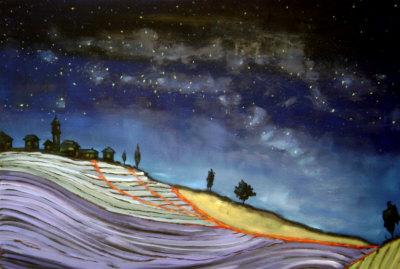3 February 2011
Landslides in Art Part 9: Raimondo Motta
Posted by Dave Petley
Regular readers will know that I occasionally feature pieces of art that depict landslides. Usually this is the visual arts (i.e. paintings); sometimes it involves music. The previous editions can be found here:
Today’s edition features a modern painting by the Italian artist Raimondo Motta.
He describes himself as follows: “I am born in 1975. I came to painting in 1987. I started with watercolor but felt rapidly that oil painting would match my way of being. In 2007 I become a member of the association “La Bottega dell’arte” and participate to the events of the group.” Most of his works are painted in oils, and many are landscapes. The piece in question is called simply “Landslide in Italy“:
Incidentally, the painting is for sale for $300, or it is possible to buy prints for $30 at the above site.
There is much to like about this painting. The colours are rich and dramatic, and the setting is interesting. The dark sky at the top of the painting creates a slightly imposing and forbidding impression, maybe symbolising both the coming of night and of a disaster. From a technical perspective if it also interesting. First, the artist has captured the role of tectonic setting in landslides. On the fight, at the toe of slope, there is a clear fault – presumably a thrust given the configuration – implying a danger of earthquakes. The skies are clear, so maybe this is meant to symbolise an impending earthquake-triggered event. The lithologies under the village show small amounts of tectonic folding too – perhaps parasitic folds on the major fault. The thicknesses of the individual units vary considerably, maybe suggesting that these are young, Flysch-type deposits on the margin of the mountains. The landslide itself is clearly rotational; the main block has been heavily disrupted, suggesting an older feature. Extending up the slope are two retrogressive components; part of one of is threatening two houses, both of which have lights on (i.e. the are occupied). Note that the lithologies are displaced across the shear surfaces – movement has already occurred on these surfaces. The steep scarp in the middle block may hint at some earlier movement event.
All-in-all this captures the silent, threatening nature of landslides, with an unsuspecting population at risk of disaster.
Thoughts and comments please on both this series of posts and on this particular piece, and I also welcome ideas for future postings on this theme



 Dave Petley is the Vice-Chancellor of the University of Hull in the United Kingdom. His blog provides commentary and analysis of landslide events occurring worldwide, including the landslides themselves, latest research, and conferences and meetings.
Dave Petley is the Vice-Chancellor of the University of Hull in the United Kingdom. His blog provides commentary and analysis of landslide events occurring worldwide, including the landslides themselves, latest research, and conferences and meetings.
[…] This post was mentioned on Twitter by Chris Rowan, Daves Landslide Blog. Daves Landslide Blog said: Landslides in Art Part 9: Raimondo Motta: The latest edition of landslides in art, this time featuring a paintin… http://bit.ly/hS6FsO […]
Art and geology together; Very cool!
[…] is the visual arts (i.e. paintings); sometimes it involves music. The previous edition can be found here. Today’s edition was pointed out to me by Anthony Miner in Australia, so many thanks to […]